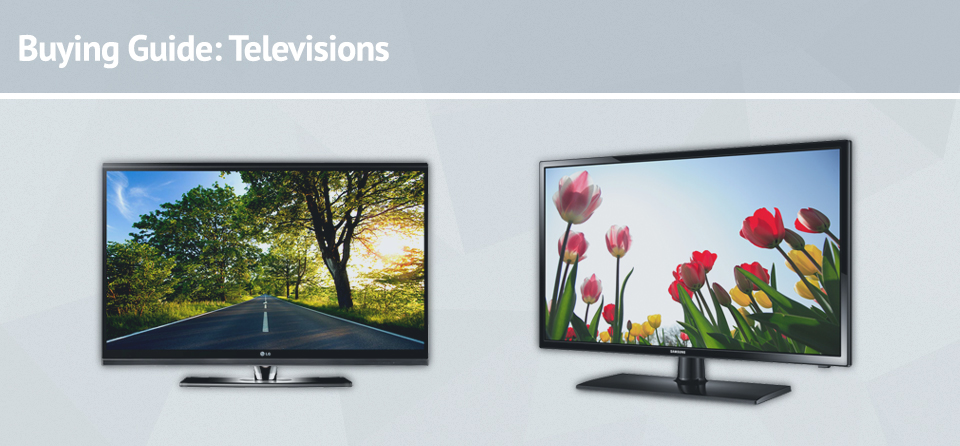Buying Guide: Televisions
Choosing A Television Set
There are so many television options flooding the market that it can be challenging to choose the one that’s right for you. Here is a complete review of television sizes, specifications, and features to guide your decision.
What Are My Options?
There are three standard categories you can expect to see when choosing a set.
LCD TVs
LCD stands for “liquid crystal display.” The name identifies the crystalline matter that’s stored inside a single pixel. Light travels from a bulb through a pixel before it is transported to the viewer’s eyes. LCDs are typically budget-friendly, bright, and efficient. You’ll typically experience screen uniformity that will allow you to enjoy a movie or television show without experiencing irritating splotches or distortions in the picture.
LED TVs
LED television sets are just like LCD sets in their reliance on crystal-filled pixels. The key difference is that LED TVs operate using “light-emitting diodes” that don’t rely as heavily on electricity as standard LCD sets. These televisions can offer bright whites, deep blacks, and an immersive contrasting color range. Based on the upgraded picture quality, LED sets tend to cost more than standard LCD sets.
Plasma TVs
Plasma television sets rely on gas-infused pixels, which are individually controlled by an electric charge. These sets offer higher refresh rates, so the viewer sees smooth, unbroken movement on the screen. Plasma televisions offer clear and brilliant color contrasts.
What Should I Look For In A Television?
Look for these specifications as you browse for a perfect set.
HDTV or Analog
HDTV: High definition television, or HDTV, is a method of broadcasting television that coordinates with your television set. HDTV broadcasts video digitally. HDTVs have a higher resolution, so the viewer sees images with more detail, brighter colors, greater contrast, and close-to-life imagery. These sets are designed to match the peripheral range of the viewer’s eye for a natural, more comfortable viewing experience.
Analog: Analog television sets transport pictures through radio frequencies and corresponding signal voltage. Analog television sets may alternately be marked “NTSC.” While some television shows are still broadcast in analog, most are moving to digital broadcasting. A converter can be used to receive digital broadcasts on an analog television set.
Refresh Rate
Refresh rate is measured in Hz, which identifies how many images can be shown per second. A higher refresh rate means a clearer picture, even when characters or objects are in motion on screen.
- 60Hz: Displays 60 images per second. The standard refresh rate for HDTVs.
- 120Hz: Displays 120 images per second.
- 240Hz: Displays 240 images per second. The standard required refresh rate for 3D television sets.
Display Resolution
The display resolution of a television set refers to the maximum amount of image detail that the television can deliver.
- 720p: Displays a maximum of 1280×720 pixels.
- 1080p: Displays a maximum of 1920×1080 pixels. Capable of displaying every pixel of an HDTV broadcast.
- 1080i: A field-based set that produces double the frames-per-second of a 1080p television set for a more fluid picture.
- 2160p: Displays a maximum of 3840×2160 pixels. Offers four times the definition of a 1080p television set. May also be called 4K UltraHD or UHD.
- 4320p: Displays a maximum of 7680×4320 pixels. Offers the maximum amount of picture definition. May also be called 8K UltraHD or UHD.
Upgrades
These optional features can turn your television set into an immersive viewing experience.
Smart TV: Also called a connected or hybrid television, a Smart TV is connected to the Internet and allows you to access applications that you can download and utilize just as you would on a smartphone or tablet. Smart televisions can allow you to surf the Web, stream media, or connect to your computer right from your set.
3D TV: 3D television sets add optical depth to flat images, giving viewers the feeling that the images and characters are leaping out of the television towards them. 3D TVs typically require the purchase and use of 3D glasses. These sets can also broadcast standard 2D television shows and films.
When buying your television set, take the time to consider the features that are most important to you. Whether it’s incredible sound, beautiful imagery, or simply great value, there is likely to be one key point that will drive your buying decision more so than any other.







